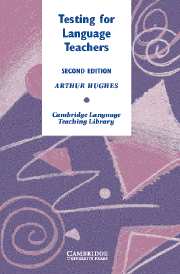Book contents
- Frontmatter
- Contents
- Acknowledgements
- Preface
- 1 Teaching and testing
- 2 Testing as problem solving: an overview of the book
- 3 Kinds of tests and testing
- 4 Validity
- 5 Reliability
- 6 Achieving beneficial backwash
- 7 Stages of test development
- 8 Common test techniques
- 9 Testing writing
- 10 Testing oral ability
- 11 Testing reading
- 12 Testing listening
- 13 Testing grammar and vocabulary
- 14 Testing overall ability
- 15 Tests for young learners
- 16 Test administration
- Appendix 1 The statistical analysis of test data
- Appendix 2 Item banking
- Appendix 3 Questions on the New Zealand youth hostels passage
- Bibliography
- Subject Index
- Author Index
15 - Tests for young learners
Published online by Cambridge University Press: 05 May 2010
- Frontmatter
- Contents
- Acknowledgements
- Preface
- 1 Teaching and testing
- 2 Testing as problem solving: an overview of the book
- 3 Kinds of tests and testing
- 4 Validity
- 5 Reliability
- 6 Achieving beneficial backwash
- 7 Stages of test development
- 8 Common test techniques
- 9 Testing writing
- 10 Testing oral ability
- 11 Testing reading
- 12 Testing listening
- 13 Testing grammar and vocabulary
- 14 Testing overall ability
- 15 Tests for young learners
- 16 Test administration
- Appendix 1 The statistical analysis of test data
- Appendix 2 Item banking
- Appendix 3 Questions on the New Zealand youth hostels passage
- Bibliography
- Subject Index
- Author Index
Summary
This chapter begins by suggesting a general approach to tests for young learners. It then goes on to consider the particular requirements of such tests. Finally it recommends suitable testing techniques.
General approach
While in some countries, for example Norway, children have been learning foreign languages at primary school for decades, in recent years it is has become an increasingly common phenomenon in many other parts of the world. This chapter considers the particular requirements for the successful testing of young learners and makes suggestions as to how this may best be done. By young learners we have in mind children aged from about five to twelve.
One might ask first why we have to test young language learners at all. This is a good question. Not everyone does it. In Norway, for example, where the learning of English appears to be highly successful, children up to the age of thirteen are not formally tested in the subject. One answer to the question might be that we want to be sure that the teaching programme is effective, that the children are really benefiting from the chance to learn a language at an early age. But this invites a further question: Why is testing rather than assessment by other means necessary? The answer I gave in Chapter 1 was that there was a need for a common yardstick, which tests give, in order to make meaningful comparisons.
- Type
- Chapter
- Information
- Testing for Language Teachers , pp. 199 - 214Publisher: Cambridge University PressPrint publication year: 2002



